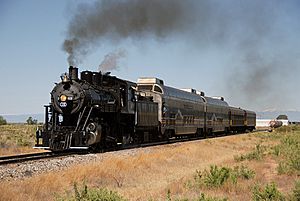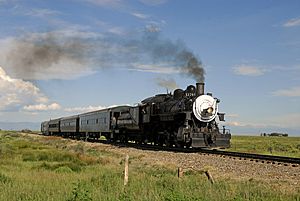Rio Grande Scenic Railroad facts for kids
Quick facts for kids Rio Grande Scenic Railroad |
|
|---|---|

No. 18, a 2-8-0, leads an excursion through Blanca, Colorado in 2008.
|
|
| Commercial operations | |
| Name | Denver and Rio Grande Western Railroad |
| Built by | Denver and Rio Grande Railway |
| Original gauge | 3 ft (914 mm) After 1899: 4 ft 8 1⁄2 in (1,435 mm) standard gauge |
| Preserved operations | |
| Owned by | San Luis and Rio Grande Railroad Iowa Pacific Holdings |
| Operated by | Rio Grande Scenic Railroad |
| Stations | Alamosa, Fort Garland, Fir Summit, La Veta |
| Length | (?) |
| Preserved gauge | 4 ft 8 1⁄2 in (1,435 mm) |
| Commercial history | |
| Opened | 1878 |
| 1899 | Gauge conversion and name change |
| Closed to passengers | (?) |
| Closed | (?) |
| Preservation history | |
| 2006 | Opened |
| 2019 | Ceased operations |

The Rio Grande Scenic Railroad was a special train line in Colorado. It was owned by a company called Iowa Pacific Holdings. This train ran from 2006 to 2019. It used tracks that belonged to the San Luis and Rio Grande Railroad.
The railroad was about 200 miles (320 km) south of Denver, Colorado. It traveled between the towns of Alamosa and La Veta. This route used standard tracks, which are 4 ft 8 1⁄2 in (1,435 mm) standard gauge wide.
The journey included a climb over the Sangre de Cristo Mountains at Veta Pass. This route dates back to 1899. It followed an older, narrower train line built in 1878 by the Denver and Rio Grande Railway. That older line used 3 ft (914 mm) tracks.
The Denver & Rio Grande Western Railway once had a famous saying: Scenic Line of the World. The trip between Alamosa and La Veta certainly lived up to this. Passengers could see many of Colorado’s tall mountains, some over 14,000 feet (4,267 meters) high. The railroad stopped running trips after a wildfire damaged some of its buildings. Also, the main company went through a difficult financial time in late 2019.
Contents
Discovering the History of the Rio Grande Scenic Railroad
This railroad's story begins with its earlier version. That first train line helped connect the San Luis Valley to the rest of the world. It did this by building tracks across the valley's edges.
How Alamosa Town Was Built
The town of Alamosa was created very quickly in 1878. Buildings were brought in by the Denver and Rio Grande Western Railroad. By 1890, and for the next 50 years, Alamosa was a major center for narrow gauge trains in North America. Narrow gauge means the tracks are narrower than standard ones.
A Busy Train Hub
Trains left from the original station in downtown Alamosa. This is where freight trains once brought in things like ore, wood, sheep, and farm products. They also shipped out crops and mining materials. Trains from places like Denver, Durango, Creede, Salida, and Santa Fe, New Mexico arrived and left daily with passengers.
Exploring the Locomotives of the Rio Grande Scenic Railroad
The Rio Grande Scenic Railroad had a collection of old and special trains. These included both steam engines and diesel engines.
Famous Steam Engines
One notable steam engine they used was No. 18. This engine was built in 1910 by the American Locomotive Company. Before coming to the Rio Grande Scenic, it worked on the Grand Canyon Railway and the Mount Hood Railroad.
They also owned another famous engine, No. 1744. This engine used to belong to the Southern Pacific Transportation Company. It was later sold to another group and moved to the Niles Canyon Railway. As of 2021, engine No. 18 was still at the property and was available for sale.
Riding in Style: The Rolling Stock
The Rio Grande Scenic Railroad used a variety of historic passenger cars for its trips. These cars offered different ways to enjoy the journey.
- Dome Cars: Five of these cars were updated for sightseeing. They had a glass roof on top, allowing passengers to see in all directions.
- Open-Window Cars: These cars were built in the 1920s by Pullman. They had bench seats and windows that could be opened. They came from the Mount Hood Railroad.
- Open Air Observation Car: Car No. 1056, named “Lookout Mountain,” was also built by Pullman in the 1920s. It was an open-air car, meaning it had no roof or walls at the back, giving passengers a clear view. This car was very popular on special steam train trips between 1966 and 1987.
- Modern Pullman Coaches: These cars from the 1950s were restored. They had large, sealed windows, heating, air conditioning, and places to buy snacks.
- Lounge Car ‘Mardi Gras’: This was a first-class lounge car with big windows at the rounded end. It was rebuilt for the ‘City of New Orleans’ train. Some say the famous song "City of New Orleans" was written in this very car!
- Lounge Car ‘Calumet Club’: Another first-class lounge car, this one had flat observation windows at its end.
- Dining Car 448: This was a former New York Central dining car. It was restored and used to serve food on the train.
Fun Events on the Rio Grande Scenic Railroad
The Rio Grande Scenic Railroad hosted many special events throughout the year. These events made the train rides even more exciting.
- Mother’s Day Brunch: A special meal served in the dome cars for Mother's Day.
- Rails & Ales Brewfest: A festival celebrating craft beers.
- Jazz on the Tracks: Concerts held on the mountain, with live jazz music.
- Oktoberfest: A celebration with a German theme.
- Fall Foliage and Pumpkin Patch Rides: Trips to see the beautiful autumn leaves and visit a pumpkin patch.
- The Train to Christmas Town: A festive ride during the holiday season.

